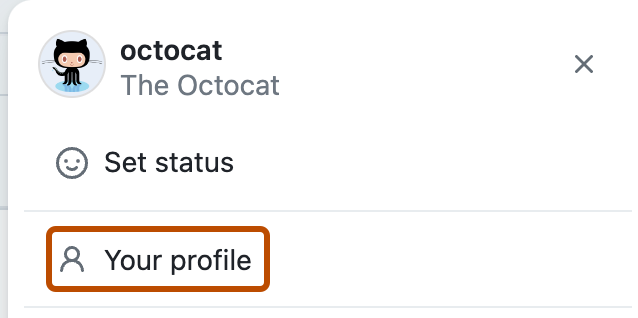When you publish a package that is scoped to a personal account or an organization, the package is not linked to a repository by default. If you connect a package to a repository, the package's landing page will show information and links from the repository, such as the README. You can also choose to have the package inherit its access permissions from the linked repository. For more information, see Configuring a package's access control and visibility.
Connecting a repository to a user-scoped package on GitHub
-
On GitHub, navigate to the main page of your personal account.
-
In the top right corner of GitHub, click your profile photo, then click Your profile.

-
On your profile page, in the header, click the Packages tab.
-
Search for and then click the name of the package that you want to manage.
-
Under your package versions, click Connect repository.
-
Select a repository to link to the package, then click Connect repository.
Connecting a repository to an organization-scoped package on GitHub
-
On GitHub, navigate to the main page of your organization.
-
Under your organization name, click the Packages tab.

-
Search for and then click the name of the package that you want to manage.
-
Under your package versions, click Connect repository.
-
Select a repository to link to the package, then click Connect repository.
Connecting a repository to a container image using the command line
Note
If you publish a package that is linked to a repository, the package automatically inherits the access permissions of the linked repository, and GitHub Actions workflows in the linked repository automatically get access to the package, unless your organization has disabled automatic inheritance of access permissions. For more information, see Configuring a package's access control and visibility.
-
In your Dockerfile, add this line, replacing
OWNERandREPOwith your details:LABEL org.opencontainers.image.source=https://github.com/OWNER/REPOFor example, if you're the user
octocatand ownmy-repoyou would add this line to your Dockerfile:LABEL org.opencontainers.image.source=https://github.com/octocat/my-repoFor more information, see LABEL in the official Docker documentation and Pre-defined Annotation Keys in the
opencontainers/image-specrepository. -
Build your container image. This example builds an image from the Dockerfile in the current directory and assigns the image name
hello_docker.docker build -t hello_docker . -
Optionally, review the details of the Docker image you just created.
$ docker images > REPOSITORY TAG IMAGE ID CREATED SIZE > hello_docker latest 142e665b1faa 5 seconds ago 125MB > redis latest afb5e116cac0 3 months ago 111MB > alpine latest a6215f271958 5 months ago 5.29MB -
Assign a name and hosting destination to your Docker image.
docker tag IMAGE_NAME ghcr.io/NAMESPACE/NEW_IMAGE_NAME:TAGReplace
NAMESPACEwith the name of the personal account or organization to which you want the package to be scoped.For example:
docker tag 38f737a91f39 ghcr.io/octocat/hello_docker:latest -
If you haven't already, authenticate to the Container registry. For more information, see Working with the Container registry.
$ echo $CR_PAT | docker login ghcr.io -u USERNAME --password-stdin > Login Succeeded -
Push your container image to the Container registry.
docker push ghcr.io/NAMESPACE/IMAGE-NAME:TAGFor example:
docker push ghcr.io/octocat/hello_docker:latest
Unlinking a repository from a package on GitHub
Note
Unlinking a package from a repository will remove the repository information from the package's landing page and can affect the access pattern depending on whether the package inherits its access permissions from the repository. For more information, see Configuring a package's access control and visibility. This behavior does not apply to Apache Maven packages, as outlined in About permissions for GitHub Packages.
-
On GitHub, navigate to the settings page of the Package you'd like to unlink.
-
On the Package settings page, you will see a Repository source section. If this section is not present, then the Package is not currently linked to a repository.
-
Click on the trash icon in the top right corner of the Repository source section.
It is possible that the Repository source section exists, but there is no trash icon present. This is because a repository source has been defined as part of the packaged code i.e. a
package.jsonfile,.gemspecfile, however, it is not actually linked to a repository on GitHub. To link the package to a repository, you will need to follow the steps in the section above.
- Confirm that you would like to unlink the repository from the package with the dialogue.
Migrating a package to another repository
If you currently have a package linked to a repository and you would like to link it to a different repository, this can be done by unlinking the package from the current repository and linking it to the new repository.
- Follow the steps to unlink it, see Unlinking a repository from a package on GitHub.
- Follow the steps to link the package to the new repository, see Connecting a repository to an organization-scoped package on GitHub or Connecting a repository to a user-scoped package on GitHub.